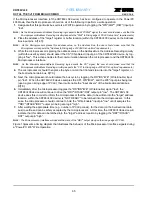
XRT86VL38
PRELIMINARY
xr
OCTAL T1/E1/J1 FRAMER/LIU COMBO
REV. P1.0.6
53
3.1
Operating the Microprocessor Interface in Intel-Asynchronous Mode
If the Microprocessor Interface has been configured to operate in the Intel-Asynchronous Mode, then the
following Microprocessor Interface pins will assume the role that is described below in Table below.
T
ABLE
4: T
HE
R
OLES
OF
V
ARIOUS
M
ICROPROCESSOR
I
NTERFACE
P
INS
,
WHEN
CONFIGURED
TO
OPERATE
IN
THE
I
NTEL
-
A
SYNCHRONOUS
M
ODE
P
IN
N
AME
420 P
KG
B
ALL
#
484 P
KG
B
ALL
#
T
YPE
D
ESCRIPTION
ALE/AS*
R22
P22
I
Address Latch Enable Input - ALE
If the Microprocessor Interface has been configured to operate in the Intel-
Asynchronous Mode, then this active-high input pin is used to latch the data
(residing on the Address Bus) into the Microprocessor Interface circuitry of the
XRT86VL38 device and to indicate the start of a READ or WRITE cycle. Pull-
ing this input pin "high" enables the input bus drivers for the Address Bus input
pins. The contents of the Address Bus will be latched into the Microprocessor
Interface circuitry, upon the falling edge of this input signal.
RD*/DS*/
WE*
W25
U21
I
Read Strobe Input - RD*
If the Microprocessor Interface is operating in the Intel-Asynchronous Mode,
then this input pin will function as the RD* (Active Low Read Strobe) input sig-
nal from the Microprocessor. Once this active-low signal is asserted, then the
XRT86VL38 device will place the contents of the addressed register on the
Microprocessor Interface Bi-directional data bus (D[7:0]). When this signal is
negated, then the Data Bus will be tri-stated.
RDY*/
DTACK*/
RDY
V24
R19
O
Active Low Ready Output - RDY*
If the Microprocessor Interface has been configured to operate in the Intel-
Asynchronous Mode, then this output pin will function as the "active-low"
READY output.During a READ or WRITE cycle, the Microprocessor Interface
block will toggle this output pin to the logic low level, ONLY when it (the Micro-
processor Interface) is ready to complete or terminate the current READ or
WRITE cycle.
Once the Microprocessor has determined that this input pin has toggled to the
logic "low" level, then it is now safe for it to move on and execute the next
READ or WRITE cycle. If (during a READ or WRITE cycle) the Microproces-
sor Interface block is holding this output pin at a logic "high" level, then the
Microprocessor is expected to extend this READ or WRITE cycle, until it
detects this output pin being toggled to the logic low level.
PCLK
Y25
V22
I
NONE - Tie to GND
WR*/R/W*
M23
L20
I
Write Strobe Input - WR*
If the Microprocessor Interface is configured to operate in the Intel-Asynchro-
nous Mode, then this input pin functions as the WR* (Active Low WRITE
Strobe) input signal from the Microprocessor. Once this active-low signal is
asserted, then the input buffers (associated with the Bi-Directional Data Bus
pin, D[7:0]) will be enabled.
The Microprocessor Interface will latch the contents on the Bi-Directional Data
Bus (into the "target" register or address location, within the XRT86VL38) upon
the rising edge of this input pin.
DBEN*
V23
U22
I
Data Bus Enable Input:
For Intel-Asynchronous Mode operation, the user should either tie this pin to a
logic "low" or assert this pin (e.g., toggle it to a logic "low") when performing a
READ operation with the Microprocessor Interface of the XRT86VL38 device.
BLAST
P23
M17
I
NONE - Tie this pin to GND






























